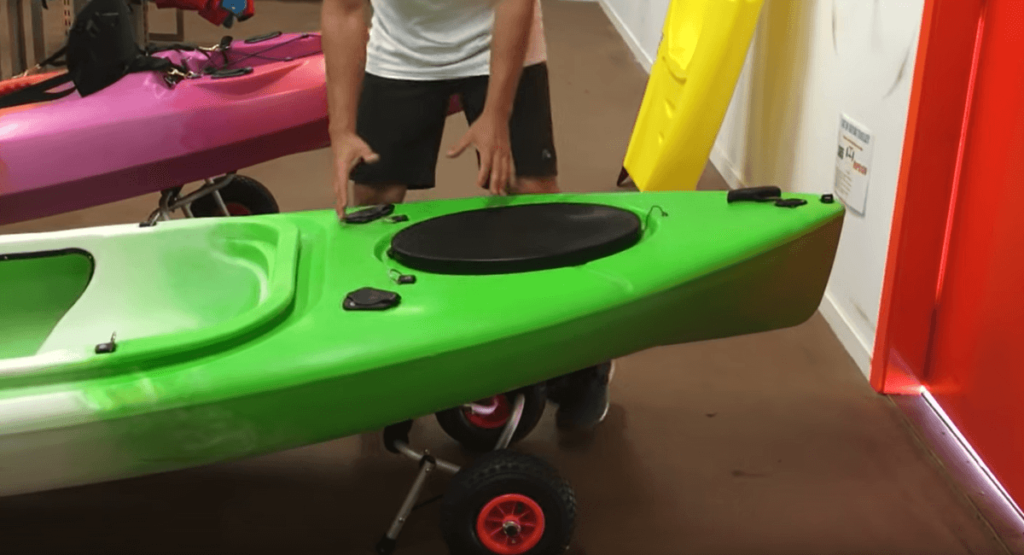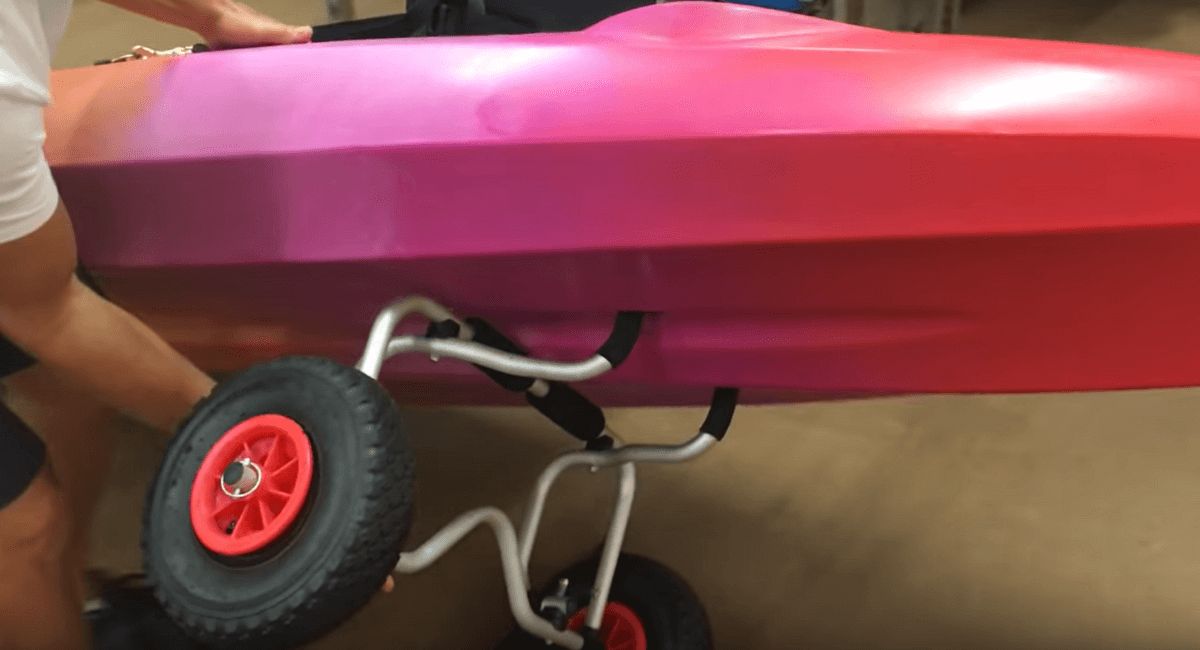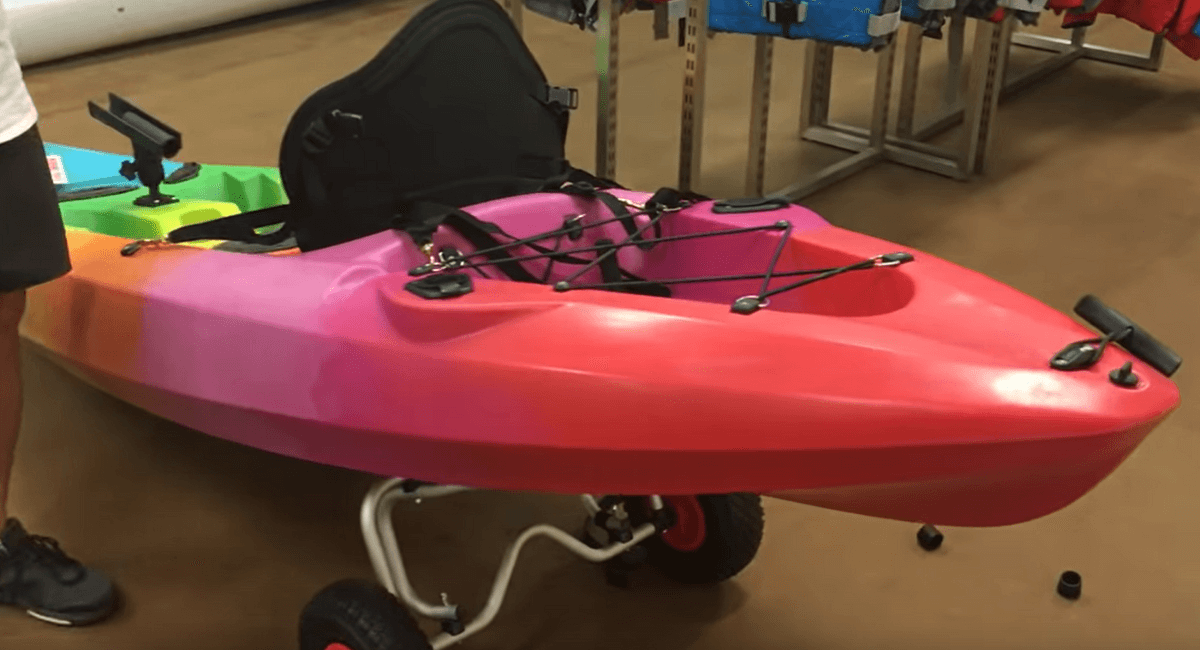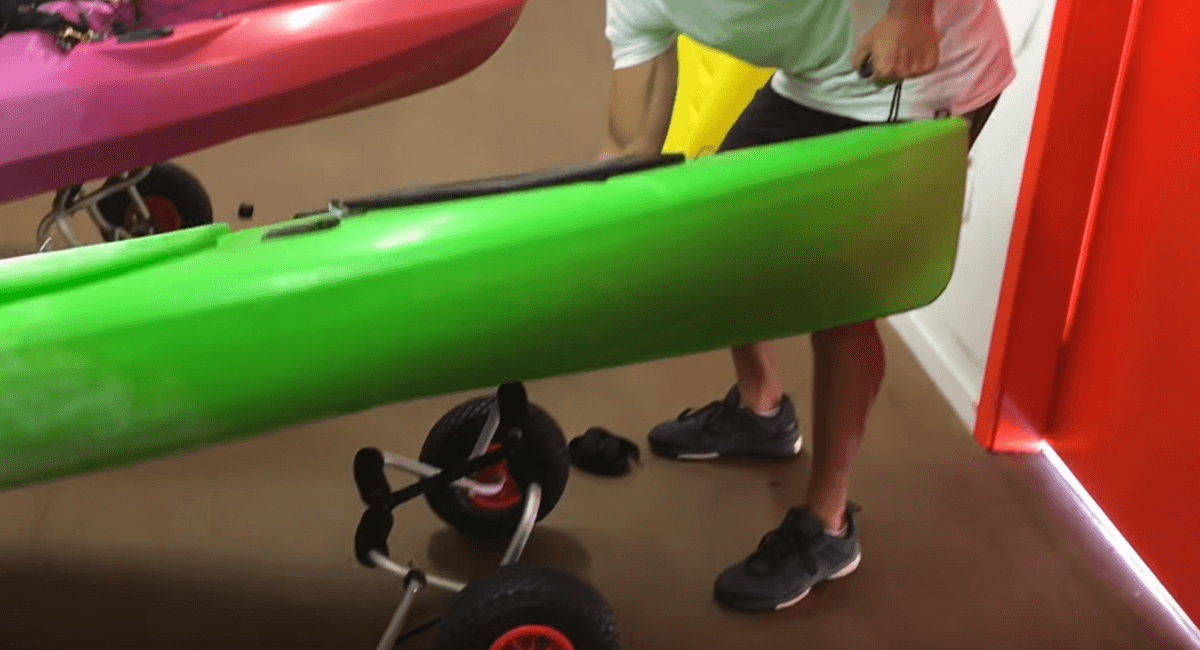Kayak trolleys work by providing a convenient way to transport kayaks from one place to another. These trolleys typically have a set of wheels and straps that secure the kayak in place, allowing users to easily maneuver their kayak over various terrains.
The trolley’s wheels help distribute the weight of the kayak, making it easier to move, especially over rough or uneven surfaces. Additionally, most kayak trolleys can be folded for storage, making them a practical accessory for any kayaker. Whether you’re navigating through a crowded marina or need to transport your kayak a distance from your vehicle to the water, a kayak trolley can significantly simplify the process and make your kayaking adventures more enjoyable.
Components Of A Kayak Trolley
A kayak trolley is a handy device that makes transporting your kayak from your vehicle to the water a breeze. Understanding the components of a kayak trolley is essential for choosing the right one for your needs.
Frame
The frame of a kayak trolley is typically constructed from lightweight, yet durable materials such as aluminum or stainless steel. It is designed to support the weight of the kayak and provide stability during transportation.
Wheels
The wheels are an integral part of a kayak trolley, providing smooth movement across various terrains. Most trolleys feature puncture-proof, solid rubber wheels that can handle rough surfaces, including sand, gravel, and uneven paths.
Straps And Buckles
High-quality straps and buckles are crucial components of a kayak trolley, ensuring secure and stable attachment of the kayak. Adjustable straps allow for a custom fit, while sturdy buckles provide reliability during transport.
Types Of Kayak Trolleys

Kayak trolleys come in various types, each designed to address specific needs and requirements. Understanding the different types will help you make an informed decision when selecting the right trolley for your kayak. Let’s take a look at a few common types of kayak trolleys.
Folding Kayak Trolleys
Folding kayak trolleys are designed with collapsible frames, allowing for easy storage and transportation when not in use. These trolleys are ideal for kayakers who value portability and space-saving features. With their compact design, they can be conveniently stowed in the kayak hatch or a storage bag, making them a practical choice for kayakers on the go.
Sit-on-top Kayak Trolleys
Sit-on-top kayak trolleys are specifically tailored to accommodate the unique hull shape and structure of sit-on-top kayaks. These trolleys often feature adjustable padded cradles to securely hold the broader and flatter hull of sit-on-top kayaks. They provide stability and ease of maneuvering, ensuring hassle-free transport from your vehicle to the water’s edge.
Choosing The Right Kayak Trolley

When selecting a kayak trolley, considering aspects like weight capacity and terrain compatibility is vital for a seamless kayaking experience. Let’s delve into the key factors to keep in mind:
Weight Capacity
The weight capacity of a kayak trolley determines its ability to carry your kayak effortlessly. Ensure it can handle your kayak’s weight to prevent any issues during transportation.
Terrain Compatibility
Checking the terrain compatibility of the trolley is crucial. Different trolleys are designed for specific terrains, such as sandy beaches, rocky paths, or smooth pavements. Choose one that suits your usual kayaking locations.
Using A Kayak Trolley

Using a kayak trolley can make your kayaking adventures more convenient and enjoyable. These nifty gadgets are designed to help you transport your kayak from your vehicle to the water with ease. But how exactly do kayak trolleys work? In this section, we will dive into the details of attaching the trolley to your kayak and loading and unloading your kayak using the trolley.
Attaching The Trolley
Attaching the trolley to your kayak is a simple process that requires just a few steps. Here’s how it’s done:
- Start by placing your kayak on a flat surface, ensuring that it is stable and won’t tip over.
- Align the trolley’s wheels with the bottom of your kayak, making sure they are centered.
- Secure the trolley to your kayak using the provided straps or clamps, ensuring a tight fit.
- Ensure that the trolley is properly secured and that it can support the weight of your kayak.
Tip: When attaching the trolley, make sure that it is positioned toward the center of your kayak for optimal balance and stability during transport.
Loading And Unloading The Kayak
Loading and unloading your kayak using a trolley is a straightforward process that saves you from the hassle of manually carrying it. Follow these steps:
- Position the trolley near the rear end of your kayak, ensuring that it is stable and won’t roll away.
- Lift the rear end of your kayak and place it onto the trolley’s frame or cradle.
- Ensure that the kayak is securely placed on the trolley and that it won’t fall off.
- Once the kayak is loaded onto the trolley, tilt it slightly towards the rear end to distribute the weight evenly.
- Push the trolley towards the water, guiding it with control. Avoid rough terrains and obstacles.
- To unload the kayak, simply reverse the process, ensuring a smooth and controlled descent.
Note: It is important to use caution and proper lifting techniques to avoid strain and injury when loading and unloading your kayak.
With these simple steps, you can easily utilize a kayak trolley to transport your kayak with ease. Whether you’re heading for a relaxing paddle on calm waters or embarking on an exciting kayaking adventure, a trolley can be a valuable accessory to enhance your experience. Now that you know how to attach the trolley and load and unload your kayak, you can spend more time enjoying the water and less time struggling with transportation!
Maintenance And Care

Kayak trolleys work by providing a convenient way to transport your kayak to and from the water. These trolleys typically feature sturdy wheels and a frame that securely holds the kayak, making it easier to move across various terrains. By using a kayak trolley, you can reduce the strain on your body and ensure proper maintenance and care for your kayak.
Maintaining your kayak trolley is essential to prolong its lifespan and ensure optimal performance on your water adventures. By following a few simple maintenance and care practices, you can keep your trolley in top-notch condition for years to come. In this section, we will explore some cleaning and storage tips, as well as how to maintain the wheels of your kayak trolley.
Cleaning And Storage Tips
Proper cleaning and storage are crucial components of kayak trolley maintenance. Here are some tips to keep your trolley looking and functioning at its best:
- After each use, rinse off any dirt, sand, or saltwater from your trolley using fresh water. This will prevent corrosion and salt buildup.
- Avoid using harsh chemicals or abrasive cleaners when cleaning your trolley, as these can damage the finish or materials. Instead, use a mild soap or detergent.
- Thoroughly dry your trolley before storing it. Moisture left on the trolley can lead to rust or mold growth.
- Store your kayak trolley in a dry, well-ventilated area away from direct sunlight. Excessive heat and UV rays can degrade the materials and weaken the trolley.
- If possible, disassemble the trolley when storing it to save space and prevent any unnecessary strain on the components.
Maintaining The Wheels
The wheels of your kayak trolley are crucial for effortless transportation. To ensure they function smoothly, follow these maintenance tips:
- Regularly inspect the wheels for any signs of damage or wear, such as cracks or flat spots. Replace any worn or damaged wheels promptly.
- Keep the wheels clean and free of debris. Use a soft brush or cloth to remove any dirt or sand that may accumulate.
- Check the tire pressure regularly, as low or unevenly distributed pressure can affect the stability and maneuverability of the trolley. Follow the manufacturer’s guidelines for optimal tire pressure.
- If your trolley has pneumatic (air-filled) wheels, ensure they are properly inflated according to the recommended pressure.
- Apply a lubricant, such as silicone spray, to the wheel bearings to maintain smooth rotation. Avoid using excessive amounts of lubricant, as it can attract dirt and debris.
Following these maintenance and care tips will help you get the most out of your kayak trolley. By keeping it clean, properly storing it, and maintaining the wheels, you can enjoy many hassle-free trips with your kayak.
Safety Considerations
Kayak trolleys work by providing a convenient way to transport kayaks to and from the water. These trolleys are designed with sturdy wheels and a durable frame to ensure stability and safety during transport. By evenly distributing the weight of the kayak, trolleys help reduce strain on the paddler and minimize the risk of injury.
Securing The Kayak
Use sturdy straps to secure the kayak onto the trolley correctly.
Proper Lifting Techniques
Adopt the correct lifting posture to avoid straining your back.
Frequently Asked Questions Of How Do Kayak Trolleys Work
How Do Kayak Trolleys Make Transportation Easier?
Kayak trolleys feature durable wheels and easy-to-use straps that allow effortless transport of kayaks over various terrains. Users simply secure the kayak onto the trolley and easily wheel it to and from the water, eliminating the need for heavy lifting.
Are Kayak Trolleys Compatible With Different Kayak Sizes?
Yes, kayak trolleys are designed to be adjustable and versatile, accommodating various kayak sizes and shapes. With adjustable arms and straps, users can customize the fit to ensure a secure and stable transport for different types of kayaks without any hassle.
What Are The Benefits Of Using A Kayak Trolley?
Using a kayak trolley reduces strain on your body by eliminating the need to lift and carry your kayak over long distances. It also protects your kayak from damage while moving it on rough surfaces, making transportation more convenient and hassle-free.
Can Kayak Trolleys Be Easily Stored And Transported?
Yes, kayak trolleys are typically lightweight and compact, making them easy to store in your kayak or vehicle when not in use. They can be disassembled for convenient transportation and quickly reassembled when needed, providing a portable solution for kayak transportation.
Conclusion
In a nutshell, kayak trolleys simplify the transport of your kayak. They offer convenience and ease during loading and unloading. Investing in a kayak trolley can enhance your overall paddling experience. So, make sure to choose the right one for your needs!
